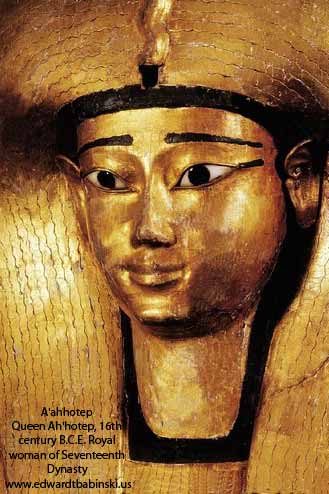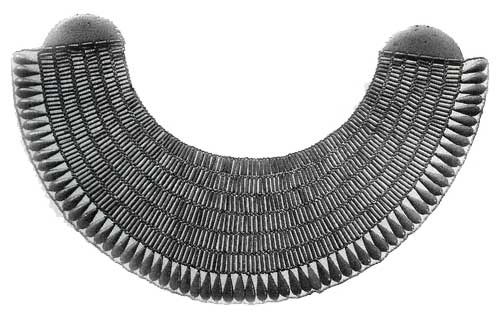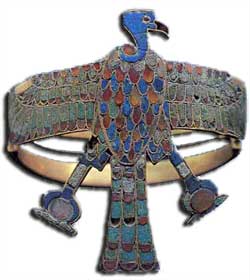Queen of Ancient Egypt, whose tomb was discovered and opened in 1856 by the French archaeologist Auguste-Édouard Mariette, contained jewels belonging to either the 17th dynasty Kamosi period pharoah whose wife A'ahhotep may have been, or to the period of Ahmose, believed to have been the son of the queen. Among the jewels which were discovered, bracelets and breastplates.
Funk and Wagnalls, ©1950 paraphrased

Seventeenth Dynasty and New Kingdom
In the five and one-half centuries between rise of the Seventeenth Dynasty and the end of the Twentieth Dynasty (circa 1630-1075), traditional jewelry forms continued, but some such as earrings and fingers rings, appear in far greater numbers than before. During this period jewelry design evolved from refined works reminiscent of Old and Middle Kingdom style to creations of unprecedented extravagance.
These changes can be seen, for example, in the development of royal head ornaments. The simple silver circlet of King Nebkheperre Inyotef VI of the Seventeenth Dynasty reproduces the basic form of the Old Kingdom boatman's fillet. A gazelle head-dress from the tomb of three minor wives of Thutmose III reflects an emerging interest in innovation tempered by an adherence to tradition. The craftsmen fashioned a T-shaped band of gold that was bent to fit over the crown of the head and around the forehead and temples of the wearer.
By the reign of Tutankhamun at the end of the Eighteenth Dynasty Egyptian aesthetic tastes had come to favor complex, ornate designs apparent in the treatment of the king's diadem. To the ancient form of the boatman's fillet, the craftsman added inlaid gold heads of both a vulture and a uraeus cobra. In a bold departure from earlier forms, the cobra's undulating body arches dramatically over the diadem until it articulates with an intricate papyrus knot at the rear. A pair of thin gold ribbons falls from the knot, and two additional streamers, each with a massive uraeus, project from the papyrus blossoms.
The wesekh became an important element of New Kingdom attire among the royalty and upper classes. Most examples consist of tubular faience beads with an outer row of drop beads.

Wesekh

Bracelet of Queen Ahhotep, gold, inlaid with lapis lazuli, carnelian and turquoise.
Throughout the new kingdom, however, craftsmen devised variations on the wesekh. The gold collar of Queen Ahhotep, the mother of King Ahmose (Amosis), the founder of the Eighteenth Dynasty, features beads in the form of stalking lions, seated cats, leaping ibexes and gazelles, winged uraei, and flying vultures. Amuletic devices are also known. A broad collar from the tomb of the minor wives of Thutmose III uses tiny inlaid nefer signs (signifying "good" or "beautiful") in places of conventional tubular beads. Versions of the Old and Middle Kingdom flexible, beaded bracelet with gold spacers and clasps appear in the burials of Queen Ahhotep and the three wives of Thutmose III. These tombs also yielded bracelets and amulets of new and unexpected types. From Ahhotep's tomb comes a complex gold armlet and two sphinxes flanking a hollow cartouche-shaped box decorated with hieroglyphs that render Ahmose's name set into a lapis lazuli background. Each of the wives of Thutmose III had four bracelets decorated with thin inset plaques of carnelian, turquois, feldspar, glass, or faience ribbed to imitate beadwork.
Civilizations of the Ancient Near East, Jewelry and Personal Arts in Ancient Egypt, pp. 1611-1612, Jack M. Sasson
Ah'hotep, 16th century B.C.E. Royal woman of Seventeenth Dynasty
Ah'hotep was the consort of Sekenenre Ta'o II (c. 1560 B.C.E.) also mother of the founder of the New Kingdom, 'Ahmose (r. 1550-1525 B.C.E.) The daughter of Senakhtenre Ta'o I and Queen Tetisheri, Ah'hotep was raised in Deir El-Baas, north of Thebes during the same period which the Hykos, or Asiatics, reigned over the northern territories. She was the mother of two sons, Kamose and 'Ahmose, and two daughters 'Ahmose-Nefertari and 'Ahmose-Hetempet.
When Ta'o II began the war of unification, Ah'hotep assumed position of guardian over the Theban throne. She received Ta'o's body when he was killed, then sent her oldest son, Kamose on the crusade. Kamose died in 1550, and 'Ahmose became the new pharoah. Ah'hotep served as regent for this young son, and giving him in marriage to his sister, 'Ahmose-Neferteri, who was possibly the widow of Kamose. For almost ten years, Ah'hotep ruled the Theban lands of southern Egypt. When 'Ahmose began his magnificent crusade against the Asiatics, Ah'hotep maintained order and pushed for military recruitment. Her name is associated with that of 'Ahmose in inscriptions, as in the fortress of Buhen, south of Aswan on the Nile.
Ah'hotep died at ninety years of age, after unification of the nation and was given a vast mortuary complex at Thebes, her resting place being located near Kamose. Great offerings were provided at her burial, including the military honor of an axe and golden boat mounted on a wooden chariot with bronze wheels. 'Ahmose praised her on a stela at Karnak, saying "She is the one who performed the rites and cared for Egypt." The immense coffin of Ah'hotep was found in 1881. Mummified remains of Ah'hotep were discovered in a small tomb near the entrance to the Valley of the Kings. No original tomb has ever been identified.

Ah'hotep, 17th Dynasty
The God's Wife
During the transitional period from the 17. to the 18. Dynasty, both, Sander-Hansen (1940) and Troy (1986), mention Ah-hotep I (see left statue above, from western Thebes, today at Paris) as first woman who held the title "Hmt nTr n Jmn". Ah-hotep I is the daughter of Senachtenre and Teti-Scheri, the wife of Seqenenre Tao, the mother of Ah-mose, of Ah-mose-Nefertari (see right statue above, today on show in the Louvre) and further daughters, and the grandmother Amen-hotep I. The listing of Ah-hotep I. among the "God's Wife" is not completely undisputed. While Sander-Hansen points out that for Ah-hotep I the title is only testified posthumous from the times of Thutmosis I, Troy mentions already three references: stela of a man from Edfu (CG 34009; Urk. IV, 29ff), a scene in the (Ramessid) tomb of Amenemopet (TT A18) who is depicted libating to Amenhotep I. and Ahhotep, and a set of 4 coffins with reference to the cult of Ahhotep, Ahmose-Nefertari, and Amenhotep I, Deir el-Bahari, priest's cachette (Cairo 6137-8, 6156-7). Nevertheless, some authors still exclude her from the list of the "God's Wife".
Depending on the fact whether the respective author accepts the references for Ah-hotep I or not her daughter, Ah-mose-Nefertari, is usually listed as the 1. or 2. woman who had held this title. She has been the wife Ah-mose, the mother of king Amenhotep I and some daughters (Sat Amun, Merit Amun I (= Ah-mose-Merit-Amun I) and, perhaps, of Sat Kamose who likewise all had held the office).
Source: History of the God's Wife in the 18. Dynasty
Ah'hotep (2) (16th century B.C.E.) Royal woman of Eighteenth Dynasty
Ah'hotep was consort of Amenhotep I (r. 1525-1504 B.C.E.) The daughter of 'Ahmose and Queen 'Ahmose-Nefertari, Ah'hotep married her brother and it is listed of her, "King's Daughter, King's Wife, King's Mother." Amenhotep I left no heir to the throne, his son by Ah'hotep named Amunemhet, died during infancy. The baby was discovered among mummies buried alongside his aunt, 'Ahmose-Merytamon. Ah'hotep was buried in Thebes.
Encyclopedia of Ancient Egypt, Margaret R. Bunson paraphrased
